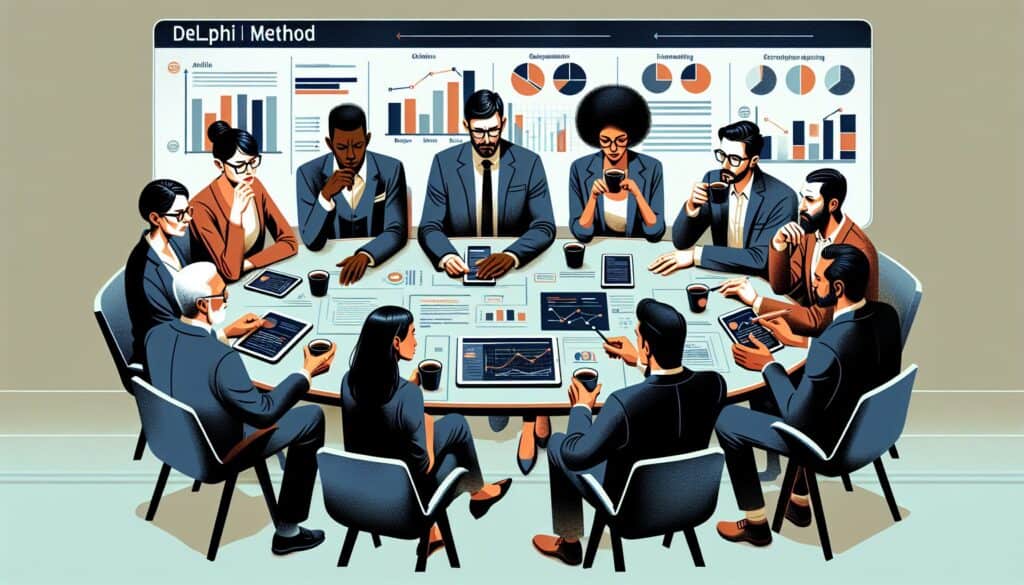To achieve a consensus on a specific topic or forecast future eventi by surveying a panel of experts through multiple rounds of questionnaires.
- Metodologie: Lean Sigma, Produzione
Metodo Delphi

Metodo Delphi
- Gestione del cambiamento, Metodologia, Gestione del progetto, Analisi statistica
Obiettivo:
Come si usa:
- Un facilitatore raccoglie pareri anonimi da un gruppo di esperti su una questione specifica. I risultati vengono riassunti e riproposti agli esperti in turni successivi, consentendo loro di rivedere le proprie opinioni in base alla risposta collettiva del gruppo, fino a raggiungere un consenso.
Professionisti
- Consente il contributo di esperti geograficamente dispersi; l'anonimato riduce l'influenza delle personalità dominanti e del pensiero di gruppo; fornisce un modo strutturato per aggregare il giudizio degli esperti.
Contro
- Può richiedere molto tempo a causa di più round; si basa sull'esperienza e sull'impegno dei membri del panel; i pregiudizi del facilitatore possono influenzare i risultati.
Categorie:
- Clienti e marketing, Risoluzione dei problemi, Gestione del progetto, Gestione del rischio
Ideale per:
- Prevedere le tendenze future o raggiungere il consenso degli esperti su questioni complesse in cui non sono disponibili dati precisi.
The Delphi Method is particularly effective in scenarios such as technological forecasting, where opinions about future advancements and their potential impacts are sought, making it suitable for industries like pharmaceuticals, information technology, and telecommunications, where expert projections influence R&D investments and strategic direction. Its application extends to project management phases that involve risk assessment, market analysis, and policy development, allowing organizations to harness expert knowledge during the planning and ideation stages. Participants typically include a broad range of experts from academia, industry, and government, which enriches the depth of analysis and encourages interdisciplinary collaboration. The anonymity of responses not only lowers the pressure on experts to conform to majority views but also promotes a richer variety of ideas and perspectives. Facilitators can effectively manage the process to mitigate pregiudizi, ensuring that less vocal experts still contribute meaningful insights. Results generated through multiple rounds offer a quantified representation of expert sentiment, aiding in the identification of trends and uncertainties that may not be obvious at first glance. As such, it serves as a strategic tool for decision-makers looking to derive consensus on innovative solutions or emerging challenges where empirical data is limited or non-existent.
Fasi chiave di questa metodologia
- Define the specific issue or topic for the Delphi study.
- Select a diverse panel of experts relevant to the topic.
- Conduct the first round of surveys to gather expert opinions anonymously.
- Analyze the responses and identify key themes or points of agreement and disagreement.
- Provide a summary of findings back to the experts for further consideration.
- Facilitate subsequent rounds of feedback, allowing experts to revise their opinions.
- Repeat the feedback and revision process until consensus is approached.
Suggerimenti per i professionisti
- Incorporate diverse expertise by selecting panelists from various disciplines to enhance perspective breadth and minimize biases.
- Utilize iterative feedback intervals efficiently, ensuring each round is brief and focused on specific themes to maintain engagement and clarity.
- Document and analyze changes in expert opinions between rounds to identify patterns or shifts that inform consensus-building effectively.
Leggere e confrontare diverse metodologie, raccomandiamo il
> Ampio archivio di metodologie <
insieme ad altre 400 metodologie.
I vostri commenti su questa metodologia o ulteriori informazioni sono benvenuti su sezione commenti qui sotto ↓ , così come tutte le idee o i link relativi all'ingegneria.
Contesto storico
1960
1980
1983
1990
1995
2000
2010
1950
1980
1980
1986
1994
1995
2000
(se la data non è nota o non è rilevante, ad esempio "meccanica dei fluidi", viene fornita una stima approssimativa della sua notevole comparsa)














Post correlati
Gestione delle operazioni di produzione (MOM)
Sistema di esecuzione della produzione (MES)
Piano di controllo della produzione
Test manuali
Schede di valutazione della movimentazione manuale (MAC)
ManTRA (Strumento di valutazione dei rischi delle attività manuali)